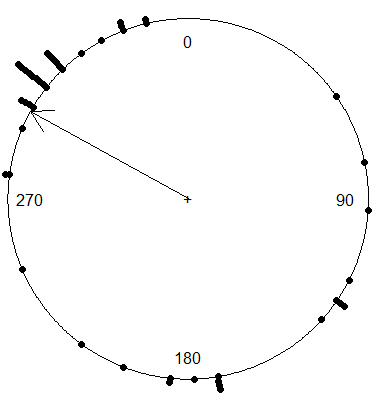Hometowns of students on the Mathematics course at UFSJ - MG
a study using Circular Statistics
Keywords:
Directional data, Circular descriptive statistics, Unit circleAbstract
A common feature in Brazilian universities is to welcome students not only from the city where the institution is located, but also from nearby cities. Some relocate to the city where the university is situated, while others commute daily to obtain their degrees. Many students in the Mathematics program at the Federal University of São João del-Rei (UFSJ) are not originally from São João, and this article is based on the geographic coordinates of their hometowns. Location is a crucial tool for analyzing the disposition of human activities in space, and in the unit circle, the coordinates will be treated as angles centered on the city of São João. Traditional statistics study data expressed on the real line, where 1 and 360 are values separated by hundreds of numbers. These characteristics do not capture the continuity of the circle, where 1 and 360 are neighboring angles. Thus, this study used circular data, calculating circular descriptive measures such as mean, variance, median, length of the resultant mean vector, and circular scatter plots. The objective of this study was to locate the region that, on average, has the most students in the Mathematics program at UFSJ. It can then be inferred that the influence zone of this UFSJ program is concentrated in the cities southeast of the host city, around 309o(circular mean).
References
ABDAL, A.; NAVARRA, J. "Uni por Uni, eu escolhi a que era do lado da minha casa": Deslocamentos cotidianos e o acesso, a permanência e a fruição da universidade por bolsistas do ProUni no Ensino Superior privado. Novos estudos CEBRAP, p. 65-87, 2014.
ALBANO, C. O sentido da interpretação nas cidades do ouro - São João Del Rei e Tiradentes. In:ALBANO, Celina; MURTA, Stela Maris (orgs). Interpretar o patrimônio - um exercício do olhar. Belo Horizonte: UFMG, 2002. 288p.
BENADUCE, H. S. C.; SILVA, A. M. Inferência e caracterização através de estatística circular para dados de direção do vento. Monografia (especialização) - Universidade Federal de Santa Maria, Centro de Ciências Naturais e Exatas, Curso de Especialização em Estatística e Modelagem Quantitativa, RS, 2020.
CRUZ, A. C.; NADÚ, P. H. S.; TORRES, D. A. R. Caracterização do perfil socioeconômico dos discentes da Universidade Federal de São João Del Rei residentes em repúblicas. São João del-Rei, 2013.
DA SILVA, C. T. S.; BRIGHENTI, C. R. G. Regressão linear-circular para modelagem de dados meteorológicos. Revista de Gestão e Secretariado, [S. l.], v. 14, n. 10, p. 16347–16359, 2023.
DE PAULA, E. W.; BRIGHENTI, C. R. G. Estatística circular: um estudo direcional, via coordenadas geográficas, dos alunos aprovados na Escola Preparatória de Cadetes do Ar. REMAT: Revista Eletrônica da Matemática, Bento Gonçalves, RS, v. 9, n. 2, p. e3008, 2023.
HADDAD, M. Ambientes virtuais de aprendizagem (AVAs) no ensino presencial e semipresencial de graduação da UFSJ. São João del-Rei, 2013.
JAMMALAMADAKA, S. R.; SENGUPTA, A.; SENGUPTA, A. Topics in circular statistics. World scientific, 2001.
MARDIA, K. V.; JUPP, P. E.; MARDIA, K. V. Directional statistics. New York: Wiley, 2000.
R CORE TEAM. R: A language and environment for statistical computing. R Foundation for Statistical Computing, Vienna, Austria. 2023. ISBN 3-900051-07-0. Disponível em: http://www.R-project.org/.

Downloads
Published
Versions
- 11-04-2024 (2)
- 15-03-2024 (1)
How to Cite
Issue
Section
License
Proposta de Política para Periódicos de Acesso Livre
Autores que publicam nesta revista concordam com os seguintes termos:
- Autores mantém os direitos autorais e concedem à revista o direito de primeira publicação, com o trabalho simultaneamente licenciado sob a Licença Creative Commons Attribution que permite o compartilhamento do trabalho com reconhecimento da autoria e publicação inicial nesta revista.
- Autores têm autorização para assumir contratos adicionais separadamente, para distribuição não-exclusiva da versão do trabalho publicada nesta revista (ex.: publicar em repositório institucional ou como capítulo de livro), com reconhecimento de autoria e publicação inicial nesta revista.
- Autores têm permissão e são estimulados a publicar e distribuir seu trabalho online (ex.: em repositórios institucionais ou na sua página pessoal) a qualquer ponto antes ou durante o processo editorial, já que isso pode gerar alterações produtivas, bem como aumentar o impacto e a citação do trabalho publicado (Veja O Efeito do Acesso Livre).
